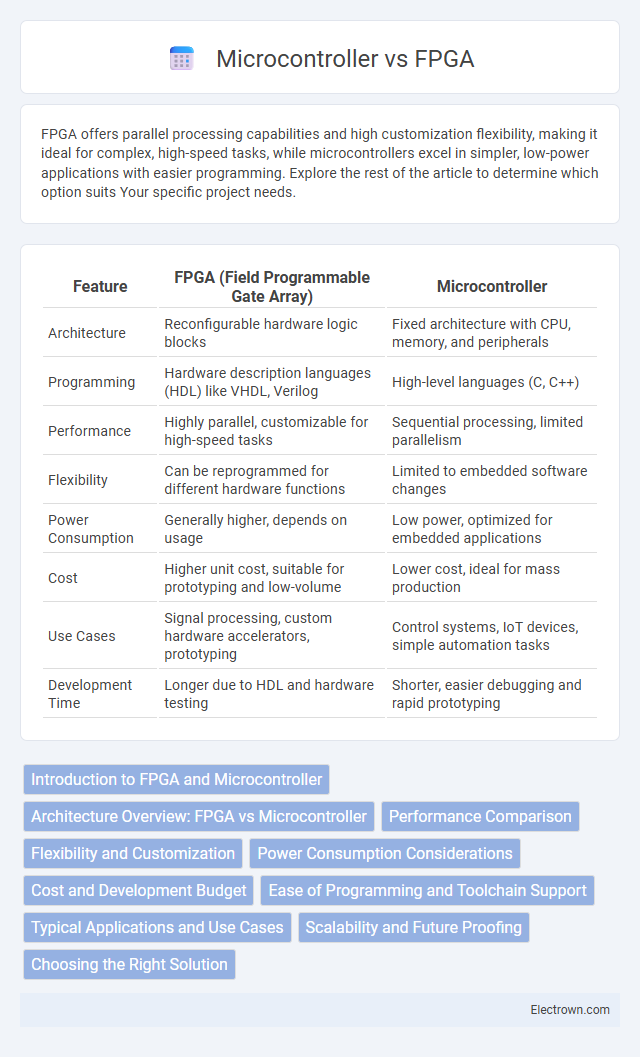FPGA offers parallel processing capabilities and high customization flexibility, making it ideal for complex, high-speed tasks, while microcontrollers excel in simpler, low-power applications with easier programming. Explore the rest of the article to determine which option suits Your specific project needs.
Table of Comparison
| Feature | FPGA (Field Programmable Gate Array) | Microcontroller |
|---|---|---|
| Architecture | Reconfigurable hardware logic blocks | Fixed architecture with CPU, memory, and peripherals |
| Programming | Hardware description languages (HDL) like VHDL, Verilog | High-level languages (C, C++) |
| Performance | Highly parallel, customizable for high-speed tasks | Sequential processing, limited parallelism |
| Flexibility | Can be reprogrammed for different hardware functions | Limited to embedded software changes |
| Power Consumption | Generally higher, depends on usage | Low power, optimized for embedded applications |
| Cost | Higher unit cost, suitable for prototyping and low-volume | Lower cost, ideal for mass production |
| Use Cases | Signal processing, custom hardware accelerators, prototyping | Control systems, IoT devices, simple automation tasks |
| Development Time | Longer due to HDL and hardware testing | Shorter, easier debugging and rapid prototyping |
Introduction to FPGA and Microcontroller
Field-Programmable Gate Arrays (FPGAs) are integrated circuits designed for hardware acceleration, allowing for custom digital logic configurations through programming. Microcontrollers are compact processors embedded with memory and peripherals, optimized for executing specific control tasks in embedded systems. Understanding your project requirements helps determine whether the parallel processing power of an FPGA or the straightforward control of a microcontroller is more suitable.
Architecture Overview: FPGA vs Microcontroller
FPGA architecture consists of an array of configurable logic blocks (CLBs) interconnected via programmable routing, enabling parallel processing and hardware-level customization. In contrast, microcontrollers feature a fixed architecture with a central processing unit (CPU), memory, and peripherals integrated on a single chip, optimized for sequential execution and control tasks. FPGAs offer flexibility in designing custom digital circuits, while microcontrollers provide simplicity and efficiency for embedded applications.
Performance Comparison
FPGA devices deliver unparalleled parallel processing capabilities, enabling significantly higher performance for complex algorithms and real-time data handling compared to microcontrollers, which operate sequentially with limited processing speed. Your applications requiring high throughput and low latency benefit from FPGAs' customizable hardware structure, while microcontrollers excel in simpler, deterministic tasks with lower power consumption. Performance metrics such as clock frequency, processing speed, and latency clearly favor FPGAs for intensive computing challenges, making them ideal for high-performance embedded systems.
Flexibility and Customization
FPGAs offer unparalleled flexibility through reconfigurable hardware, allowing designers to tailor the logic architecture to specific applications and update it post-deployment. Microcontrollers rely on fixed hardware architectures with pre-defined instruction sets, limiting customization but simplifying software development and integration. For use cases demanding bespoke processing and parallelism, FPGAs excel, whereas microcontrollers suit standardized tasks with established firmware.
Power Consumption Considerations
FPGA power consumption varies depending on the design's complexity and operating frequency, often leading to higher dynamic power compared to microcontrollers, which are typically optimized for low-power, real-time applications. Microcontrollers feature integrated power management modes such as sleep and standby, significantly reducing energy use during idle periods, making them ideal for battery-powered devices. Your choice between FPGA and microcontroller should weigh these power consumption characteristics against performance and flexibility requirements.
Cost and Development Budget
FPGA development typically involves higher initial costs due to expensive hardware and specialized design tools, making it less budget-friendly for small-scale projects compared to microcontrollers. Microcontrollers offer a lower-cost entry point with extensive ecosystem support and simpler programming, reducing overall development expenses. Your choice should consider the balance between upfront investment in FPGA flexibility and the cost-efficiency of microcontroller solutions.
Ease of Programming and Toolchain Support
Microcontrollers offer a more straightforward programming experience with widely available integrated development environments (IDEs) and extensive libraries, making them ideal for rapid prototyping and simpler applications. FPGA development requires specialized hardware description languages (HDLs) like VHDL or Verilog and complex toolchains such as Xilinx Vivado or Intel Quartus, which have steeper learning curves and longer development cycles. Despite this, FPGA toolchains have improved, providing simulation, synthesis, and debugging capabilities crucial for customizable hardware design.
Typical Applications and Use Cases
FPGAs excel in high-performance computing, digital signal processing, and real-time data processing where parallelism and customization are critical, often found in telecommunications, aerospace, and automotive systems. Microcontrollers dominate in embedded systems for consumer electronics, home automation, and simple control applications due to their low power consumption and ease of programming. Both platforms serve distinct roles, with FPGAs ideal for complex, high-speed tasks and microcontrollers optimized for cost-effective, low-complexity control functions.
Scalability and Future Proofing
FPGAs offer superior scalability and future proofing compared to microcontrollers due to their reconfigurable hardware architecture, allowing you to update and customize functionality without redesigning physical components. Microcontrollers have fixed architectures, limiting their adaptability as application demands grow or change. Choosing FPGAs ensures your system can evolve with emerging technologies and increasing performance requirements.
Choosing the Right Solution
Choosing between FPGA and microcontroller depends on project requirements such as performance, flexibility, and complexity. FPGAs excel in parallel processing, high-speed data handling, and hardware-level customization, making them ideal for applications like signal processing and real-time computing. Microcontrollers offer cost-effective, low-power solutions with integrated peripherals, suitable for simpler control tasks and embedded systems.
FPGA vs microcontroller Infographic

 electrown.com
electrown.com